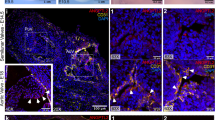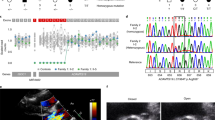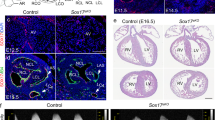Abstract
Atrioventricular and semilunar valve abnormalities are common birth defects, but how cardiac valvulogenesis is directed remains largely unknown. During studies of genetic interaction between Egfr, encoding the epidermal growth factor receptor, and Ptpn11, encoding the protein-tyrosine-phosphatase Shp2, we discovered that Egfr is required for semilunar, but not atrioventricular, valve development. Although unnoticed in earlier studies1,2, mice homozygous for the hypomorphic Egfr allele waved-2 (Egfrwa2/wa2) exhibit semilunar valve enlargement resulting from over-abundant mesenchymal cells. Egfr−/− mice (CD1 background) have similar defects. The penetrance and severity of the defects in Egfrwa2/wa2 mice are enhanced by heterozygosity for a targeted mutation of exon 2 of Ptpn11 (ref. 3). Compound (Egfrwa2/wa2:Ptpn11+/−) mutant mice also show premature lethality. Electrocardiography, echocardiography and haemodynamic analyses showed that affected mice develop aortic stenosis and regurgitation. Our results identify the Egfr and Shp2 as components of a growth-factor signalling pathway required specifically for semilunar valvulogenesis, support the hypothesis that Shp2 is required for Egfr signalling in vivo, and provide an animal model for aortic valve disease.
This is a preview of subscription content, access via your institution
Access options
Subscribe to this journal
Receive 12 print issues and online access
$209.00 per year
only $17.42 per issue
Buy this article
- Purchase on Springer Link
- Instant access to full article PDF
Prices may be subject to local taxes which are calculated during checkout




Similar content being viewed by others
References
Mclaren, A. & Bowman, P. Mouse chimaeras derived from fusion of embryos differing by nine genetic factors. Nature 224, 238–240 (1969).
Luettke, N.C. et al. The mouse waved-2 phenotype results from a point mutation in the EGF receptor tyrosine kinase. Genes Dev. 8, 399–413 (1994).
Arrandale, J.M. et al. Insulin signaling in mice expressing reduced levels of Syp. J. Biol. Chem. 271, 21353–21358 (1996).
Van Vactor, D., O'Reilly, A.O. & Neel, B.G. Genetic analysis of protein tyrosine phosphatases. Curr. Opin. Genet. Dev. 8, 112–126 (1998).
McLaren, A. The microscopic appearance of waved-2 mouse hairs. Genet. Res. 17, 257–260 (1971).
Sibilia, M. & Wagner, E.F. Strain-dependent epithelial defects in mice lacking the EGF receptor. Science 269, 234–237 (1995).
Threadgill, D.W. et al. Targeted disruption of mouse EGF receptor: effect of genetic background on mutant phenotype. Science 269, 230–234 (1995).
Miettinen, P.J. et al. Epithelial immaturity and multiorgan failure in mice lacking epidermal growth factor receptor. Nature 376, 337–341 (1995).
Sibilia, M., Steinbach, J.P., Stingl, L., Aguzzi, A. & Wagner, E.F. A strain-independent postnatal neurodegeneration in mice lacking the EGF receptor. EMBO J. 13, 719–731 (1998).
Saxton, T.M. et al. Abnormal mesoderm patterning in mouse embryos mutant for the SH2 tyrosine phosphatase SHP-2. EMBO J. 16, 2352–2364 (1997).
Wang, D.Z.M. et al. Mutation in Sos1 dominantly enhances a weak allele of the EGFR, demonstrating a requirement for Sos1 in EGFR signaling and development. Genes Dev. 11, 309–320 (1997).
Qu, C.K., Yu, W.M., Azzarelli, B. & Feng, G.-S Genetic evidence that SHP-2 tyrosine phosphatase is a signal enhancer of the epidermal growth factor receptor in mammals. Proc. Natl Acad. Sci. USA 96, 8528–8533 (1999).
Greco, T.L. et al. Analysis of the vestigial tail mutation demonstrates that Wnt-3a gene dosage regulates mouse axial development. Genes Dev. 10, 313–324 (1996).
Takada, S. et al. Wnt-3a regulates somites and tail-bud formation in the mouse embryo. Genes Dev. 8, 174–189 (1994).
Kirby, M.L. & Waldo, K.L. Neural crest and cardiovascular patterning. Circ. Res. 77, 211–215 (1995).
Luetteke, N.C. et al. Targeted inactivation of the EGF and amphiregulin genes reveals distinct roles for EGF receptor ligands in mouse mammary gland development. Development 126, 2739–2750 (1999).
Potts, J. & Runyan, R. Epithelial-mesenchymal cell transformation in the embryonic heart can be mediated, in part, by transforming growth factor β. Dev. Biol. 134, 392–401 (1989).
Potts, J.D., Dagle, J.M., Walder, J.A., Weeks, D.L. & Runyan, R.B. Epithelial-mesenchymal transformation of embryonic cardiac endothelial cells is inhibited by a modified antisense oligodeoxynucleotide to transforming growth factor β 3. Proc. Natl Acad. Sci. USA 88, 1516–1520 (1991).
Clark, E.B., Markwald, R.R. & Takao, A. Overview: cardiac morphogenesis. in Developmental Mechanisms of Heart Disease 157–168 (Futura, Armonk, 1995).
Lakkis, M.M. & Epstein, J.A. Neurofibromin modulation of ras activity is required for normal endocardial-mesenchymal transformation in the developing heart. Development 125, 4359–4367 (1998).
Kretzschmar, M., Doody, J. & Massague, J. Opposing BMP and EGF signalling pathways converge on the TGF-β family mediator Smad1. Nature 389, 618–622 (1997).
Gill, G.N. & Lazar, C.S. Increased phosphotyrosine content and inhibition of proliferation in EGF-treated A431 cells. Nature 293, 305–307 (1981).
Barnes, D.W. Epidermal growth factor inhibits growth of A431 human epidermoid carcinoma in serum-free cell culture. J. Cell Biol. 93, 1–4 (1982).
MacLeod, C.L., Luk, A., Castagnola, J., Cronin, M. & Mendelsohn, J. EGF induces cell cycle arrest of A431 human epidermoid carcinoma cells. J. Cell Physiol. 127, 175–182 (1986).
Erickson, S.L. et al. ErbB3 is required for normal cerebellar and cardiac development: a comparison with ErbB2- and heregulin-deficient mice. Development 124, 4999–5011 (1997).
Carraway, K.L.I. & Cantley, L.C. A new acquaintance for ErB3 and ErB4: a role for receptor heterodimerization in growth signaling. Cell 78, 5–8 (1994).
Ranger, A.M. et al. The transcription factor NF-ATc is essential for cardiac valve formation. Nature 392, 186–189 (1998).
de la Pompa, J.L. et al. Role of the NF-ATc transcription factor in morphogenesis of cardiac valves and septum. Nature 392, 182–186 (1998).
Kupershmidt, S. et al. Replacement by homologous recombination of the minK gene with lacZ reveals restriction of minK expression to the mouse cardiac conduction system. Circ. Res. 84, 146–152 (1999).
Lorenz, J.N. & Robbins, J. Measurement of intraventricular pressure and cardiac performance in the intact closed-chest anesthetized mouse. Am. J. Physiol. 272, 1137–1146 (1997).
Acknowledgements
We thank J. DeAngelis for help with electrocardiography; K. Converso for assistance with echocardiography; and S. Izumo, W. Quist and M. Mercola for helpful comments and criticisms. This work was supported by NIH grants R01 CA49152 and P50 HL56993-01 to B.G.N. and by HD26722 to T.M. L.D.K. is supported by an NRSA from the NIH.
Author information
Authors and Affiliations
Corresponding author
Rights and permissions
About this article
Cite this article
Chen, B., Bronson, R., Klaman, L. et al. Mice mutant for Egfr and Shp2 have defective cardiac semilunar valvulogenesis. Nat Genet 24, 296–299 (2000). https://doi.org/10.1038/73528
Received:
Accepted:
Issue Date:
DOI: https://doi.org/10.1038/73528
This article is cited by
-
RNA-Seq Analysis Reveals Altered Expression of Cell Adhesion-Related Genes Following PZR Knockout in Lung Cancer Cells
Applied Biochemistry and Biotechnology (2023)
-
A comprehensive review of SHP2 and its role in cancer
Cellular Oncology (2022)
-
Combined genetic and chemical screens indicate protective potential for EGFR inhibition to cardiomyocytes under hypoxia
Scientific Reports (2021)
-
Hypoxia-inducible factor 2-alpha-dependent induction of amphiregulin dampens myocardial ischemia-reperfusion injury
Nature Communications (2018)
-
Calcific Aortic Valve Disease: a Developmental Biology Perspective
Current Cardiology Reports (2018)



